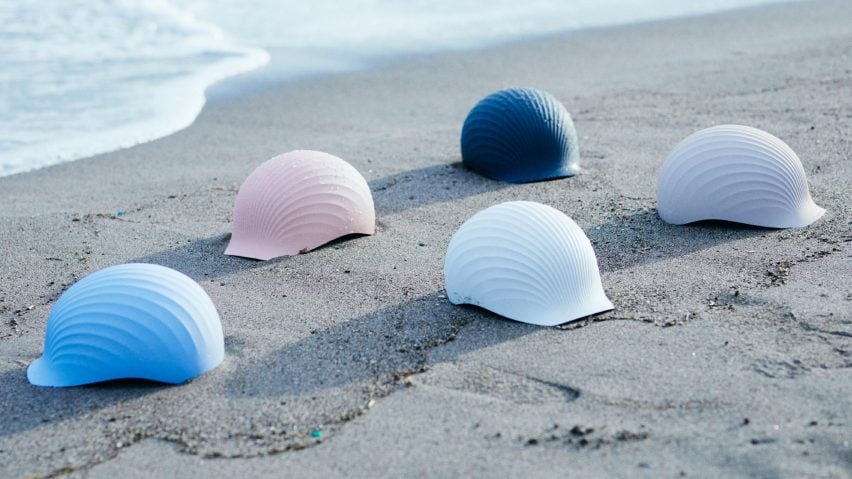From concrete-like building materials to restaurant crockery made from the eateries' own food scraps, this roundup explores eight projects created using discarded shells.
Seashells form the exoskeleton of crustaceans and molluscs and are mainly composed of calcium carbonate, which has similar properties to limestone – a common construction material.
Designers around the globe have noted the potential that shells have to form the basis of durable products by condensing and combining them with other materials. These practitioners have also attempted to address the large volume of seashells discarded annually by the food industry.
Here are eight diverse projects made from shells:
Shellware by Natural Material Studio
Leftover scallop and other seafood shells from the Danish restaurant Noma were used by Natural Material Studio and ceramicist Esben Kaldahl to make crockery including plates and bowls.
Called Shellware, the project involved heating calcium carbonate seashells to create calcium oxide, which forms a similar base material to bone ash used to make bone china – a key component of traditional ceramics.
Find out more about Shellware ›
South Korean design studio Newtab-22 created a new material by grinding down surplus seashells originally destined for landfill and mixing them with natural, non-toxic binders to form slabs featuring a terrazzo-like finish.
The calcium carbonate-rich seashells share similar properties to cement, which the studio said makes them a suitable alternative to concrete.
Known as Sea Stone, the material has been used to create products such as vases, plinths and decorative tiles.
Find out more about this Sea Stone ›
Discarded seafood shells including those from crabs were mixed with waste coffee grounds to create TômTex, a leather alternative by designer Uyen Tran. The name Tôm means shrimp in Vietnamese.
Tran made the material in an attempt to move away from traditional, carbon-intensive leather, although it can be embossed with various patterns to mimic animal leathers such as snakeskin.
"Tômtex can replicate any textural surface, so there are endless possibilities for pattern design," said the designer.
Vrå restaurant furniture by Carolina Härdh
Local designer Carolina Härdh created a stool that doubles as a side table out of oyster shells, rice starch and fish bones from the kitchen of a Japanese restaurant in Gothenburg, Sweden.
Held together with natural fish glue that develops from boiling down bones, the chunky furniture is characterised by a grey-hued, terrazzo-like surface.
To avoid creating more waste during the production process, leftover material was used to form pebble-like chopstick rests known as hashioki.
Find out more about this restaurant furniture ›
Shellworks by Ed Jones, Insiya Jafferjee, Amir Afshar and Andrew Edwards
Shellworks is a project by designers Ed Jones, Insiya Jafferjee, Amir Afshar and Andrew Edwards. The group developed a series of machines that transform discarded lobster shells into a paper-like bioplastic while studying at the Royal College of Art and Imperial College in London.
The material is made from a mixture of vinegar and chitin – a biopolymer that forms the hard exoskeleton of crustaceans as well as the cell walls of fungi.
Five machines were designed by the group to offer an alternative to the expensive and time-consuming processes involved in obtaining chitosan, the commercially available version of chitin.
Find out more about Shellworks ›
Bio-concrete by Brigitte Kock and Irene Roca Moracia
Designers and former Central Saint Martins students Brigitte Kock and Irene Roca Moracia created a material from Japanese knotweed and American signal crayfish shells that they refer to as bio-concrete.
Kock and Moracia chose these biomaterials due to the ecological and economic damage they cause in the UK as non-native, invasive species. The designers wanted to give these species a new purpose by combining them to create a material that helps to restore local biodiversity.
Find out more about this bio-concrete ›
Materials researcher and maker Carly Breame designed a menu-style collection of crockery for Angela's restaurant in Margate made from its food scraps, which includes a starter dish created from scallop, oyster and mussel shells.
"A single ceramic plate can have ten ingredients, all providing something different," Breame told Dezeen. "So essentially, I am looking to replace each ingredient with a waste source."
Find out more about Off the Menu ›
Shellmet by TBWA\Hakuhodo and Koushi Chemical Industry Co
Shellmet is a hard hat designed as protective headgear for fishing workers, which advertising agency TBWA\Hakuhodo and plastics manufacturer Koushi Chemical Industry Co created using waste scallop shells and recycled plastic.
Featuring a ridged design informed by the ribbed surface of seashells, the project intends to respond to the vast number of excess scallop shells that pile up as landfill in Japan's Sarufutsu village.
Find out more about Shellmet ›

